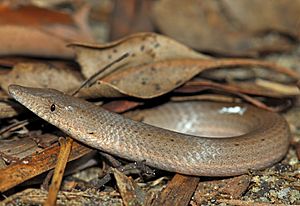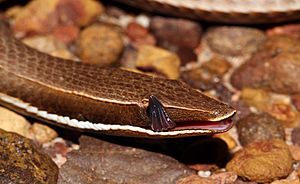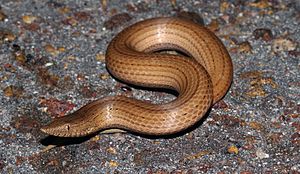Burton's legless lizard facts for kids
Quick facts for kids Burton's legless lizard |
|
|---|---|
 |
|
| Conservation status | |
| Scientific classification | |
| Genus: |
Lialis
|
| Species: |
burtonis
|
 |
|
Burton's legless lizard (Lialis burtonis) is a special kind of lizard. It looks a lot like a snake because it doesn't have front legs, and its back legs are tiny. People also call these lizards "flap-footed lizards" or "snake-lizards." You can only find them in Australia and Papua New Guinea.
Contents
What's in a Name?
The name burtonis honors a British army surgeon named Edward Burton (1790–1867).
About This Amazing Lizard
Burton's legless lizard belongs to a group of lizards called Lialis within the Pygopodidae family. There are about 40 species in the Pygopodidae family. But Burton's legless lizard and one other species (L. jicari) are the only ones in the Lialis group.
These lizards are a bit like some snakes because they can swallow big prey whole. However, there are some key differences between legless lizards and snakes:
- Legless lizards do not have venom (poison).
- They cannot squeeze their prey to kill it.
- They have a fleshy tongue, not a forked one like snakes.
- They have visible ear holes.
- They have tiny leftover back legs.
Even though they look like snakes, Burton's legless lizard and other Pygopodidae lizards are actually most closely related to geckos.
Burton's legless lizard has some cool body features that help it catch and eat large, struggling prey.
- It has a long snout and pointed, hooked teeth. These help it grip its prey.
- The long snout also helps it see better, so it can strike more accurately.
- Its jaw joints are very flexible, allowing its mouth to open wide around prey.
- It can pull its eyes back into its head. This is important because it uses its eyesight to hunt, and this protects its eyes during a struggle.
Where They Live
Burton's legless lizard lives almost everywhere in Australia, except for parts of southern Australia like Tasmania. You can also find them in Papua New Guinea, but only in one small area.
These lizards live in many different places, from deserts to the edges of rainforests. However, you won't find them in cold southern mountain areas or very hot northern deserts. They usually hide in low plants or under things on the ground, like fallen leaves. Leaf litter is very important for them, especially in tropical areas. If there isn't much leaf litter, they will use grasses, old burrows, or other shelters.
What They Eat
Burton's legless lizard mostly eats other lizards. They often eat skinks, but they also hunt other legless lizards, geckos, and dragons. Sometimes, they even eat small snakes, which scientists have found by studying museum specimens. Interestingly, these lizards do not eat very often.
Reproduction and Life Cycle
Burton's legless lizards usually mate at certain times of the year across Australia. Mating and egg development typically happen from September until summer. These lizards lay eggs, usually from November to January. However, they can lay eggs at other times, and females can lay more than one group of eggs each year. They lay their eggs under logs or rocks, on the ground, under leaf litter, and sometimes even in the nests of sugar ants.
Each group of eggs usually has 1 to 3 tough, leathery eggs, but 2 eggs is most common. Sometimes, many females will lay their eggs together in one nest. Up to 20 eggs have been found in a single nest! Females of this species can also store sperm to use later for reproduction, or they can reproduce without a male through a process called parthenogenesis. When they hatch, baby lizards are about 13 centimeters long.
How They Behave
Burton's legless lizard usually hunts during the day because that's when it's most likely to find prey. But it can be active at any time. It often moves around at night to avoid getting too hot and to stay safe from predators like birds that hunt during the day. Moving at night also helps it keep its ambush spot a secret during the day when prey is most active. How they move and hunt can also change depending on where they live, since they are found in so many different places.
This lizard is a visual hunter, meaning it strikes when it sees movement. It needs a good hiding spot to ambush its prey. Shelter also helps it hide from its own predators. After eating, these lizards tend to stay very still, which is thought to be a way to avoid being noticed by predators.
Shelter is also important for lizards to control their body temperature. For example, deep leaf litter is great because they can bury themselves at the right depth to stay warm or cool and remain hidden.
Burton's legless lizard also uses a unique hunting trick called caudal luring. This means it wiggles its tail to attract prey. This behavior only happens if its first attack misses the prey. It's more likely to use this trick if it hasn't eaten in a while. Caudal luring can help in three ways: it can lure prey closer, distract prey when the lizard strikes, or do both.
Hunting strategies are very important for this lizard. The lizards it eats can sometimes be big enough to bite back and cause serious harm. This is why Burton's legless lizard aims its strikes carefully. When attacking large prey, it aims for the head or neck to stop the prey from biting. It will also hold large prey until it stops moving before swallowing it. But with small prey, it might swallow them while they are still struggling, as this uses less energy than waiting.
This lizard also makes sounds, especially when it feels threatened. If a predator grabs it, it can drop its tail, just like many other lizards. However, growing a new tail takes a lot of time and energy.
Conservation Status
Burton's legless lizard is not currently a top concern for conservation. It is Australia's most widespread reptile and lives in almost all types of habitats. We don't know exactly how many there are, but there's no sign that this species is rare or quickly disappearing. Because of this, experts believe it would be classified as "least concern" by conservation groups.







